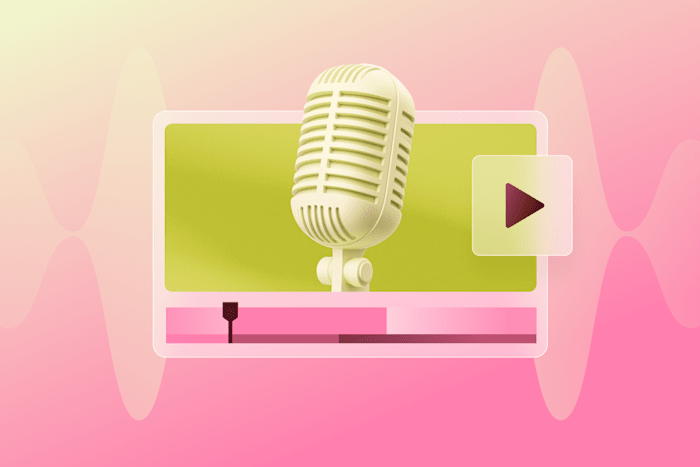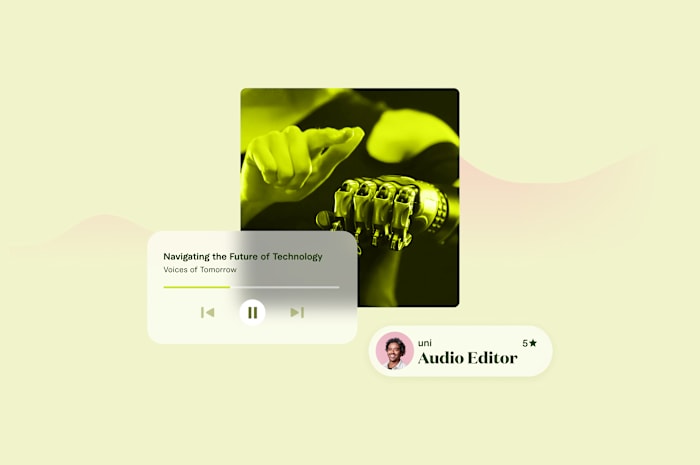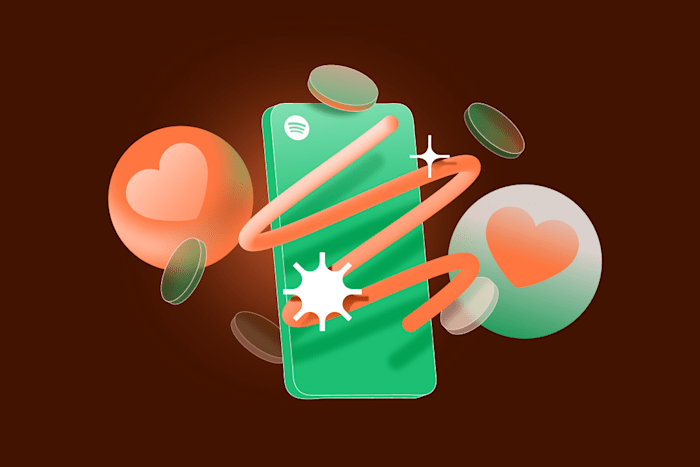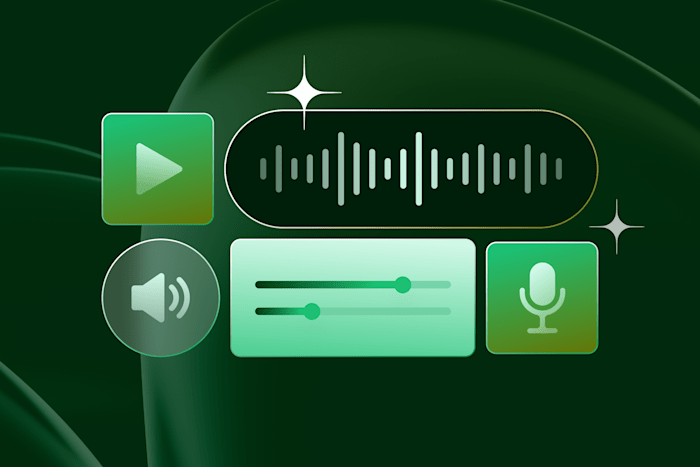What is a Podcast? Types and How They Work
Learn everything about podcasts and find the right experts to help start your show.
 April 2, 2025
April 2, 2025 7 minute reading
7 minute reading
Spotify has over 6 million podcast titles to choose from, and chances are, you’ll be one of the 584.1 million people who will tune in this year.
But you don’t have to stick to just listening. If you are a creator or business owner, there are opportunities to host your own show. All you need is recording equipment, good podcast editing, a quiet space, and content ideas — then, you can get started.
There are different styles of podcasts, including conversations, narratives, scripted fiction, and repurposed content. And, you can start a podcast to promote your brand, share stories, or dive into issues that matter to you.
From podcast basics to tips to monetize every episode, you’ll find everything you need to know in this guide.
What is a podcast?
A podcast is a digital audio program with a series of individual episodes. While most podcasts are audio-only, some now include video content. A podcast is similar to a radio show, but all the content is pre-recorded.
Podcasts can be streamed from any device to inform, inspire, and engage the audience. Listeners can learn something new or connect with others in a similar situation. Whether your listeners are curled up on the sofa, driving to work, or cleaning the house, a podcast can be the perfect companion.
When fans find a favorite, they can subscribe and will be notified when you release a new episode. Some platforms even allow subscribers to opt in so that new episodes download automatically.
Why are podcasts so popular?
Here are some fun facts that show you how popular podcasts are right now:
47% of people in the US over the age of 12 listen to podcasts every month.
YouTube is the platform with the most podcast users at 31%, followed by Spotify at 21%.
135 million people in the US listen to podcasts every month.
By 2027, China is set to have more podcast listeners than any other country in the world.

Backlinko
While podcasts can be either video or audio, audio-only episodes are typically more popular. This is for several reasons, including:
They're convenient. Users can listen to audio podcasts on the go, while doing dishes, at the gym, or driving.
They're easier and more affordable to make. Because they're audio-only, there's typically less equipment involved, and they're faster and cheaper to produce and edit.
They take up less space. Video takes up significantly more memory than an audio file.
If you’re not using podcasts, you could be missing out on a growing audience. Consider adding a few episodes to your marketing mix.
How do podcasts work?
So, how does a podcast work? Here is a step-by-step rundown:
The podcaster plans the episode, which usually involves writing a script. Thirty percent of podcasts are 20 to 40 minutes long, so keep this in mind when creating your content.
The podcaster records an episode with any guest speakers. At a minimum, you will need a quiet space, recording software, headphones, and a microphone.
You upload the podcast to the internet. You can use a third-party hosting provider such as Acast to distribute to Spotify, Apple Podcasts, Amazon Music, and more. Take the time to write catchy episode titles and descriptions.
Listeners can stream or download the episode from their favorite devices, including computers, phones, and tablets. If they like what they hear, listeners may hit the “subscribe” button.
Podcasters can upload more episodes to the series. Forty percent of podcasters upload a new episode every 8 to 14 days.
If you launch a podcast, make sure you promote every episode. Start growing your TikTok, Facebook, and Instagram profiles to spread the word. And, consider hiring expert podcast promotion services.
Find a podcast editor for hire
Types of podcasts
There are different types of podcasts. The right choice will depend on your personal style and the themes of your episodes.
Once you find something that works, stick with it. Your audience will expect the content to be consistent.
Here are a few suggestions for the types of podcasts you can host:
Conversational
Think of a conversational podcast as a chat between friends. The vibe is relaxed, and it has a personal touch.
Even though it’s conversational, the tone of voice should match the genre. If it’s a comedy show, you can be playful, witty, and chuckle at the right moments. But, if it’s a true crime podcast with heavy content, a more serious tone will be required.
Here’s an example. The Joe Rogan Experience is the second-most popular podcast in the US. Comedian Joe Rogan invites guests to appear on the show for long-form interviews.
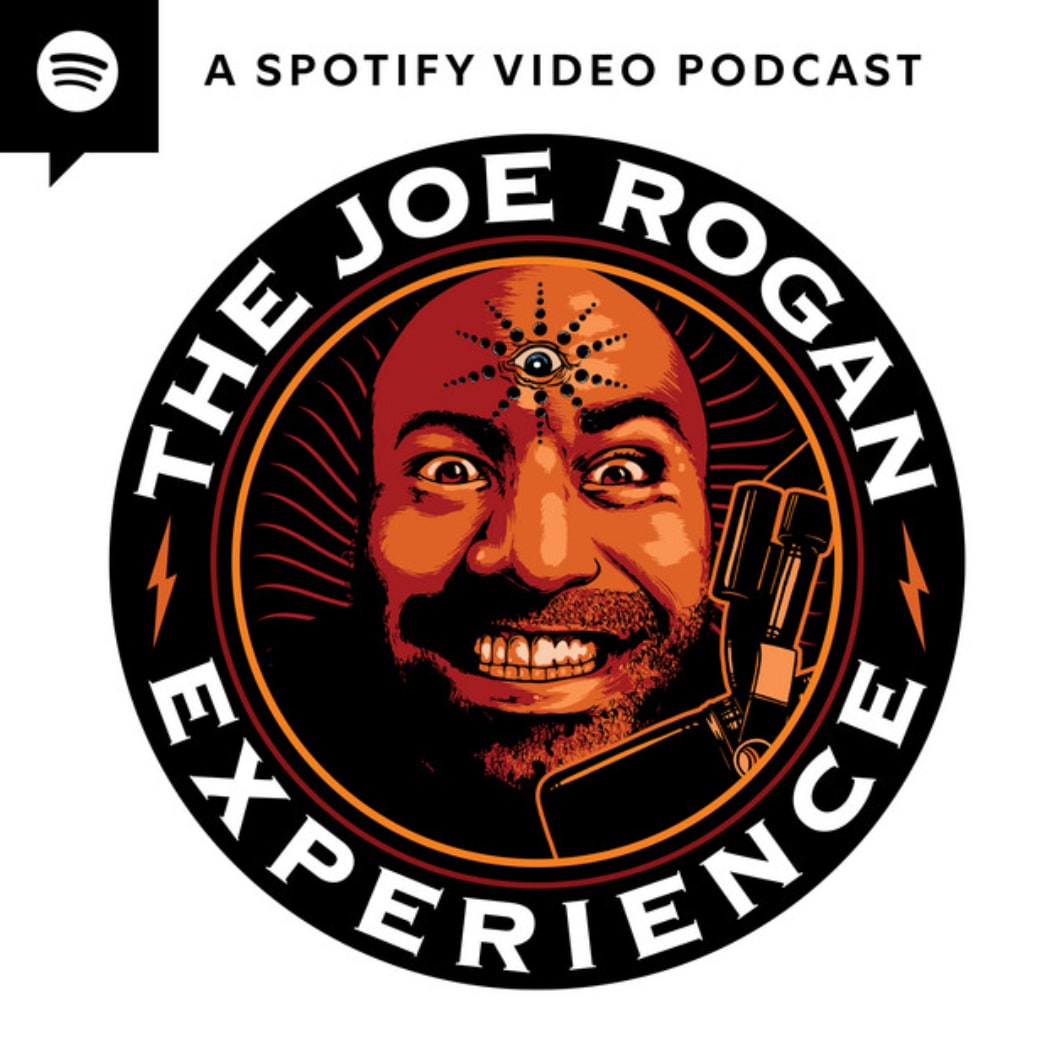
Joe Rogan
It’s a video podcast, and guests include actors, musicians, and athletes. Topics are just as diverse as the guests because Joe Rogan talks about almost anything.
Narrative
Another style option is narrative, which is all about storytelling. These podcasts have a tale to tell in a structured way — with a beginning, middle, and end.
Narrative stories usually have one or two hosts, rather than an unscripted interview format. Look at Narrative Podcast, with a new story in each episode:

Narrative Podcast
The stories come from real people and are presented by co-hosts Tim Croll and Steve Gohl.
Scripted fiction
A scripted fiction podcast can take an audience to a different world. Each episode has a script that voice actors read. You can bring the story to life with sound effects and music. You can hire someone to help you with voice overs from Fiverr, if you need help.
Like traditional novels, you will need to choose a genre, such as romantic comedy, thriller, or horror.
Take Tower 4 as an example. This series is described as a mystery/thriller:
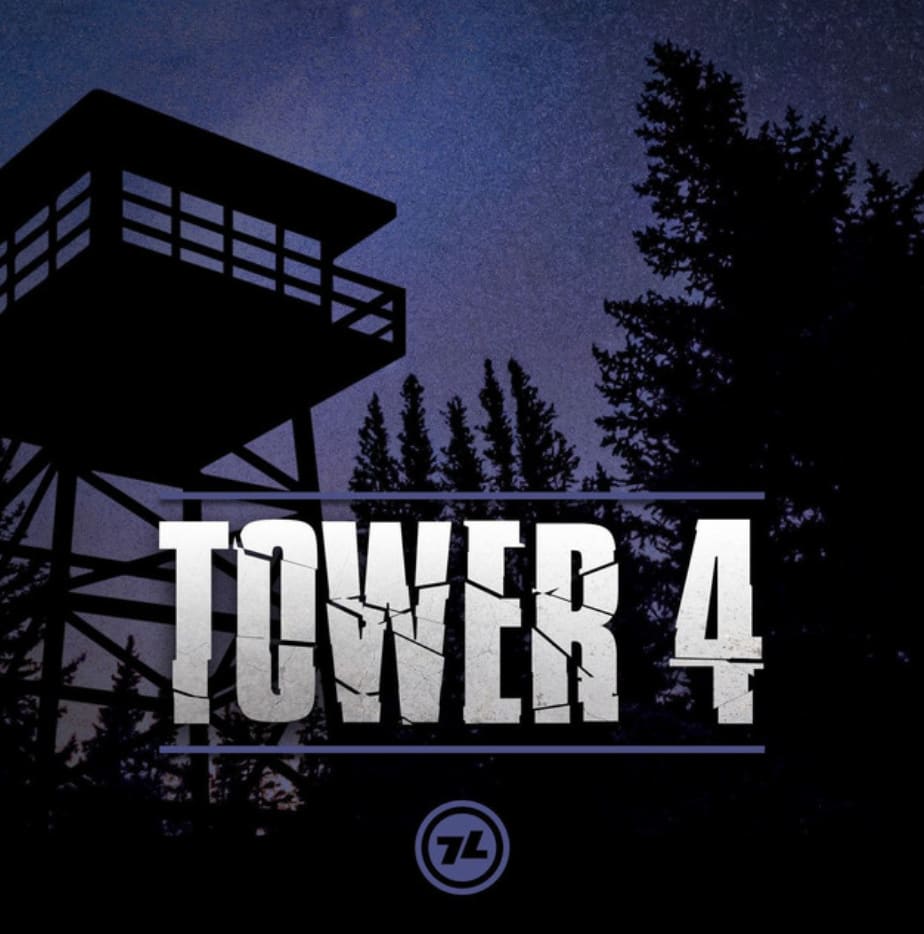
Tower 4 podcast
You have two options when creating a fictional podcast. You can follow a similar method to Tower 4, with a single story spread across the season. Or, you could have a different short story for every episode.
Want to hire a voice actor? Try a Fiverr freelancer. Or, you can use text-to-voice software to generate a realistic voiceover.
Repurposed content
Then there is repurposed content, where you take snippets from other sources and discuss the key points. It’s not uncommon for podcasters to discuss news and current affairs.
Even though you are repurposing existing content, it doesn’t mean you can’t put your own spin on things. Add opinions, expert commentators, or hot tips to make it your own.
The Daily from the New York Times is an ex of a podcast with repurposed content.

The Daily podcast
Hosts Michael Barbaro and Sabrina Tavernise record the show on weekdays, with 20-minute episodes on demand.
You can also repurpose your own podcasts as videos, social media posts, and blog posts. This takes your content further, as you can use the same ideas across a range of platforms.
Find and Hire an Expert to Repurpose Your Videos
How to listen to podcasts
There are multiple ways to listen to audio content. Stream or download episodes to your Android device, iPhone, tablet, or computer.
While you can listen from your browser, apps are a convenient choice. Listeners can sign up to keep track of their favorite podcasts. Try these:
Apple Podcasts (formerly iTunes)
YouTube Music (formerly Google Podcasts)
Remember, some platforms are free, while others have a monthly subscription fee.
How to create a podcast
Now it's time for some tips to help you create a winning podcast:
Step 1: Identify your goals
Answer the question, "Why am I creating a podcast?" For example, you may want improved search visibility, the chance to demonstrate your expertise, or a new way to network within your industry.
Step 2: Define your target audience
You shouldn't do anything without considering your target audience and the niche you want to reach. Demographic data may include:
Age
Gender
Location
Income
Occupation
Education
Interests
Use this information to craft content that appeals to your target audience.
Step 3. Choose a podcast topic
Choose a specific core topic that will define your podcast. You want this topic to be unique enough to stand out but broad enough to appeal to a wide audience.
Not sure what works? The top genre for podcasts on Spotify is comedy, with 30% of total listening hours worldwide. Society and culture is also popular, with 18% of total listening hours.
Step 4. Listen to other podcasts
Look at your competitors to see what works and what doesn’t. Check out podcast landing pages, read reviews, and understand what’s trending. Use your research to determine what type of content is the best fit for your target audience.
Step 5. Choose your format
There are multiple podcast formats to consider, including:
One-on-one interviews
Solo commentary
Conversational / co-hosted
Panel podcast
Fiction or nonfiction
Also, consider the number of episodes you want to create and the length of each one.
Find a podcast marketing specialist for hire
Step 6. Select a creative podcast name
Keep the name of your podcast short and sweet. Make sure it is interesting, attention-grabbing, and relevant so users know what to expect. When you find a name you like, get feedback from friends, family, and peers.
Spotify uses this example in its Creator Guides. “Plant Nerd” is short and sweet and much more catchy than “From Thistles to Photosynthesis: The Cactus ‘Cast:
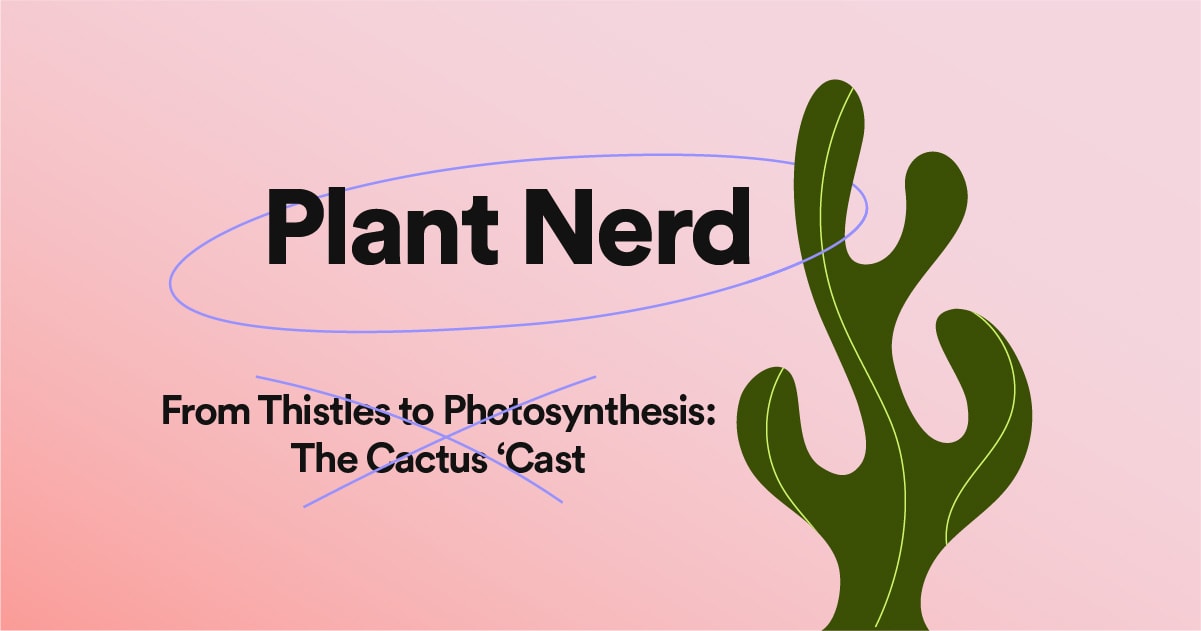
Plant Nerd
Step 7. Write out some show notes or a script
Planning what topics to cover will keep the conversation on track. Write a catchy and entertaining intro welcoming your audience and an outro including a call-to-action (CTA).
Step 8. Get the right recording equipment
To produce high-quality audio, you'll need a microphone, headphones, a pop filter, and recording and editing software.
Step 9. Set up an audio-friendly recording space
To reduce background noise, use sound treatment materials such as acoustic foam panels, sound-absorbing curtains, or sound blankets.
Step 10. Record your podcast
Once you have set up an audio-friendly recording space and captured your voice with a quality microphone, you need a way to save it.
Here are four of the most popular podcast recording solutions to consider:
Use dedicated audio software such as Audacity or Adobe Audition.
Try Zoom or Skype to chat with remote guests. You will still need recording software.
Record using a remote platform, such as Riverside.FM or Zencastr.
Use a portable recording device, such as a smartphone or voice recorder.
Step 11. Edit your podcast episodes
Import the recorded audio, delete unwanted material, improve audio quality, or simply add music or sound effects. Consider hiring a professional podcast editor to ensure the final product is high-quality.
Step 12: Design your cover art
Make your show stand out with an appealing cover image. Consider hiring someone to do the graphic design for your cover art to get it right the first time.
Step 13. Sign up with a podcast hosting company
Here you can store your audio file (MP3) and create your podcast RSS feed. Among the best podcast hosting platforms are LibSyn, Buzzsprout, and PodBean.
Step 14. Make your podcast discoverable
Distribute to podcast directories such as Apple Podcasts, and Spotify. Also consider translating your podcast into other languages to expand your reach even further.
How podcasters make money
Once you have a loyal following, you can make money from your podcast. There can be different opportunities depending on the platform, but options for monetization include:
Advertisements: Pre-recorded audio ads that play during scheduled breaks
Sponsorships: Private agreements to promote a brand during a podcast episode
Merchandise sales: Sell physical products, such as shirts, cups, and hats
Subscriptions: Subscribers get access to premium content for a recurring fee
Affiliate marketing: Promote products and brands for a commission
Here’s an example. Podcaster Pat Flynn of Smart Passive Income has built a strong audience, generating revenue through sponsorships, online courses, and affiliate marketing. He also sells merchandise and offers paid community memberships.
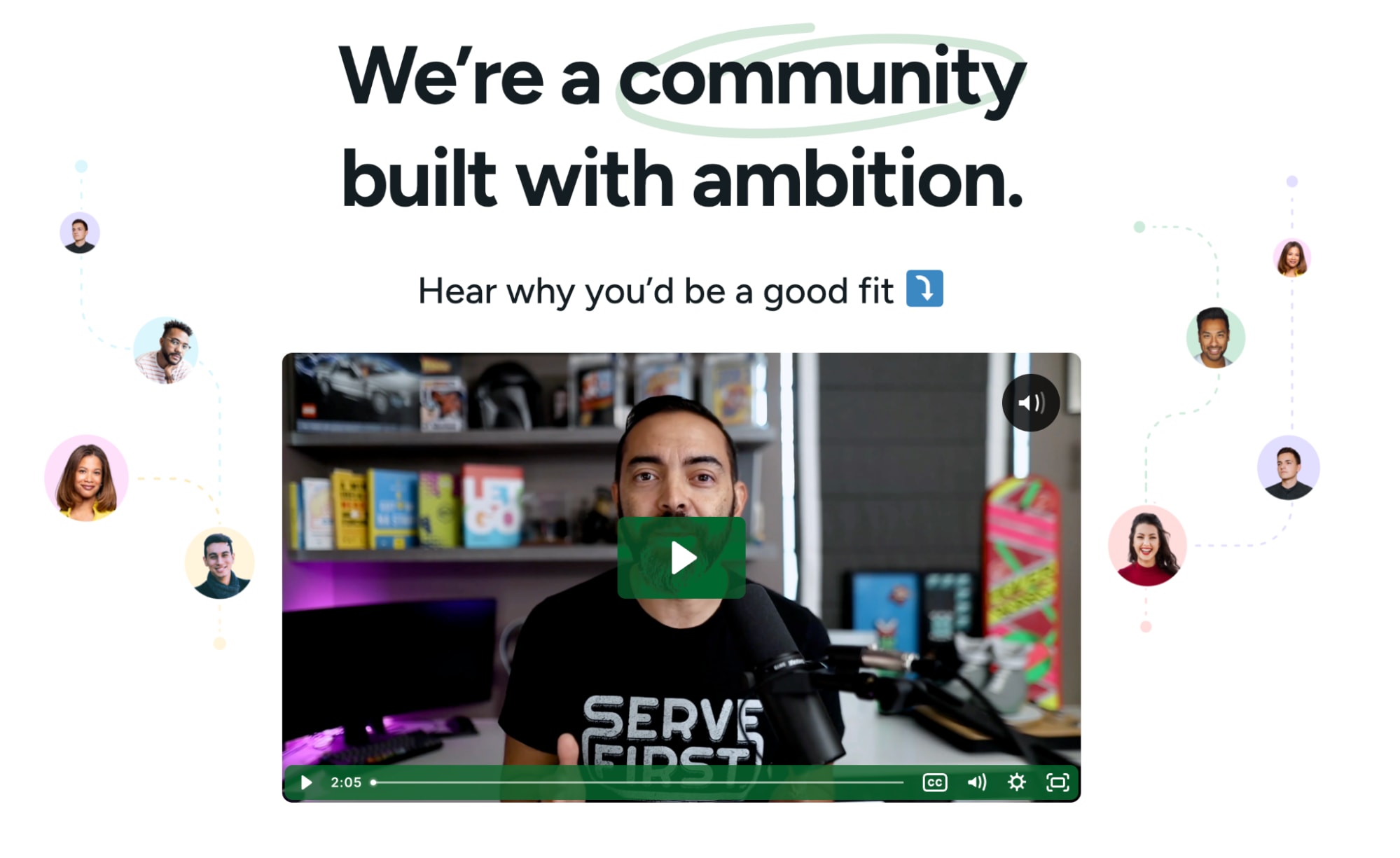
Smart Passive Income
Remember, once you grow your fan base, you can use that momentum to help you launch live shows, radio segments, and events.
Find a podcast editor for hire
Hire podcast production experts on Fiverr
Did you know you can find experts on Fiverr to help you improve your new podcast? Whether you need someone to help you write your content, a voice actor, or a translator, you’ll find the right fit for every project.
Using our platform is easy, and you can chat with creators and read reviews before committing. Plus, payments are secure so that you can work with top talent — without risk.
Podcast FAQs
What is a podcast, and how does it work?
Podcasts are audio or video recordings listeners can tune in to on-demand from their computer or mobile devices. Each podcast has different episodes, around 20 to 40 minutes long.
What is an example of a podcast?
An example of a podcast is Rotten Mango by Stephanie Soo. It’s a true-crime series where the podcasters explore the ins and outs of unique cases. Another example is The Giggly Squad, where hosts Anna and Paige put their (comedic) spin on pop culture, dating, and more.
Are podcasts free?
Most podcasts are free to listen to, but you can expect to hear a few ads. However, some podcasts have premium content you can access with a subscription.
You may also have to pay for a streaming platform such as Spotify.
What is the point of having a podcast?
A podcast can help you connect with a wide audience. You can talk about your experiences, market your brand, or inspire and educate people.
For creatives, creating original podcast content is a good way to express their personalities and earn money.

